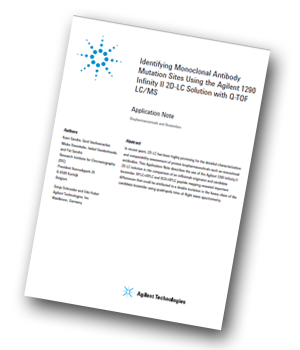Agilent Technologies has produced an application note describing the use of the Agilent 1290 Infinity II 2D-LC solution in the comparison of an infliximab originator and candidate biosimilar.
 Introduction
Introduction
Monoclonal antibodies (mAbs) have emerged as important biopharmaceuticals. Today, more than 40 mAbs are marketed in the United States and Europe, of which 18 have attained blockbuster status, with sales more than doubled since 2008. Over 50 are in late-stage clinical development. The knowledge that the top-selling mAbs are, or will become, open to the market in the coming years has resulted in an explosion of biosimilar activities. It is clear that the biosimilar market holds great potential, but it is simultaneously confronted with major hurdles. In contrast to small-molecule drugs, mAbs are large (approximately 150 kDa) and heterogeneous (due to the biosynthetic process and subsequent manufacturing and storage), making their analysis highly challenging. Online two-dimensional liquid chromatography (2D-LC) is an emerging tool used to tackle this analytical complexity.
Experimental
Sample Preparation
A 100 mM amount of DTT was added to the sample to a final concentration of 10 mM DTT following sample dilution to 0.2 mg/mL using 100 mM Tris-HCl, pH 8.0. Reduction was performed at 60 °C for 1 hour.
Results and Discussion
LC×LC peptide mapping was performed subsequently to elucidate the origin of this retention time and mass difference. Compared to 1D-LC, LC×LC is known to increase substantially the chromatographic resolution as long as the two dimensions are orthogonal, and the separation obtained in the first dimension is maintained upon transfer to the second dimension. Orthogonal combinations for 2D-LC‑based peptide
mapping are: strong cation exchange × reversed-phase LC (SCX×RPLC), hydrophilic interaction chromatography × reversed-phase LC (HILIC×RPLC) and reversed-phase LC × reversed-phase LC
(RPLC×RPLC) at different pH values in the two dimensions.
Conclusions
The Agilent 1290 Infinity II 2D-LC solution, combined with an Agilent 6530 Accurate‑Mass Quadrupole Time-of-Flight LC/MS, successfully enabled pinpointing critical differences between an infliximab originator and candidate biosimilar. A difference in the amino acid sequence of the heavy chain is revealed that a priori excludes this candidate biosimilar for further development since authorities require the amino acid sequence to be identical.




